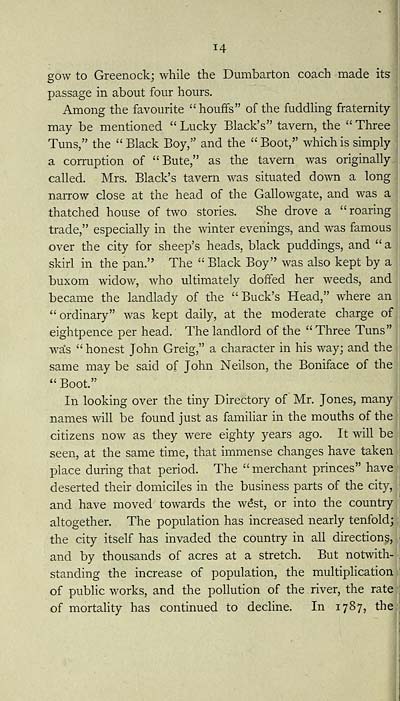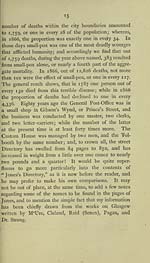Towns > Glasgow > 1787 - Reprint of Jones's directory; or, Useful pocket companion for the year 1787
(22)
Download files
Complete book:
Individual page:
Thumbnail gallery: Grid view | List view

14
gow to Greenock; while the Dumbarton coach made its
passage in about four hours.
Among the favourite "houffs" of the fuddUng fraternity
may be mentioned " Lucky Black's" tavern, the " Three
Tuns/' the " Black Boy," and the "Boot," which is simply
a corruption of "Bute," as the tavern was originally
called. Mrs. Black's tavern was situated down a long
narrow close at the head of the Gallowgate, and was a
thatched house of two stories. She drove a "roaring
trade," especially in the winter evenings, and was famous
over the city for sheep's heads, black puddings, and "a
skirl in the pan." The " Black Boy" was also kept by a
buxom widow, who ultimately doffed her weeds, and
became the landlady of the "Buck's Head," where an
"ordinary" was kept daily, at the moderate charge of
eightpence per head. The landlord of the " Three Tuns"
was "honest John Greig," a character in his way; and the
same may be said of John Neilson, the Boniface of the
" Boot."
In looking over the tiny Directory of Mr. Jones, many
names will be found just as familiar in the mouths of the
citizens now as they were eighty years ago. It will be
seen, at the same time, that immense changes have taken
place during that period. The "merchant princes" have
deserted their domiciles in the business parts of the city,
and have moved towards the w^st, or into the country
altogether. The population has increased nearly tenfold;
the city itself has invaded the country in all directions,
and by thousands of acres at a stretch. But notwith-
standing the increase of population, the multiplication
of public works, and the pollution of the river, the rate
of mortality has continued to decline. In 1787, the
gow to Greenock; while the Dumbarton coach made its
passage in about four hours.
Among the favourite "houffs" of the fuddUng fraternity
may be mentioned " Lucky Black's" tavern, the " Three
Tuns/' the " Black Boy," and the "Boot," which is simply
a corruption of "Bute," as the tavern was originally
called. Mrs. Black's tavern was situated down a long
narrow close at the head of the Gallowgate, and was a
thatched house of two stories. She drove a "roaring
trade," especially in the winter evenings, and was famous
over the city for sheep's heads, black puddings, and "a
skirl in the pan." The " Black Boy" was also kept by a
buxom widow, who ultimately doffed her weeds, and
became the landlady of the "Buck's Head," where an
"ordinary" was kept daily, at the moderate charge of
eightpence per head. The landlord of the " Three Tuns"
was "honest John Greig," a character in his way; and the
same may be said of John Neilson, the Boniface of the
" Boot."
In looking over the tiny Directory of Mr. Jones, many
names will be found just as familiar in the mouths of the
citizens now as they were eighty years ago. It will be
seen, at the same time, that immense changes have taken
place during that period. The "merchant princes" have
deserted their domiciles in the business parts of the city,
and have moved towards the w^st, or into the country
altogether. The population has increased nearly tenfold;
the city itself has invaded the country in all directions,
and by thousands of acres at a stretch. But notwith-
standing the increase of population, the multiplication
of public works, and the pollution of the river, the rate
of mortality has continued to decline. In 1787, the
Set display mode to: Large image | Transcription
Images and transcriptions on this page, including medium image downloads, may be used under the Creative Commons Attribution 4.0 International Licence unless otherwise stated. ![]()
| Scottish Post Office Directories > Towns > Glasgow > Reprint of Jones's directory; or, Useful pocket companion for the year 1787 > (22) |
|---|
| Permanent URL | https://digital.nls.uk/85272063 |
|---|
| Description | Directories of individual Scottish towns and their suburbs. |
|---|
| Description | Around 700 Scottish directories published annually by the Post Office or private publishers between 1773 and 1911. Most of Scotland covered, with a focus on Edinburgh, Glasgow, Dundee and Aberdeen. Most volumes include a general directory (A-Z by surname), street directory (A-Z by street) and trade directory (A-Z by trade). |
|---|


